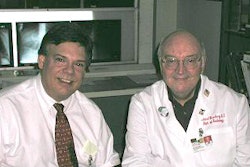Patients, attending physicians, and administrators can breathe a sigh of relief -- the majority of radiology residents in the U.S. feel well equipped to handle their on-call duties. That's the result of a recent survey that assessed residents' perceptions of their on-call experience.
"Call is probably considered by most residents to be the bane of their training, because it is a taxing, stressful experience. However, it is a necessary experience.… The opportunity for residents to make independent decisions is a significant learning experience," wrote Dr. Joshua McDonald and colleagues from the University of Iowa Hospitals and Clinics in Iowa City (Journal of the American College of Radiology, November 2005, Vol. 2:11, pp. 932-938).
In addition to assessing residents' sense of preparedness for call, the authors also asked about compliance with work hour rules set out by the Accreditation Council for Graduate Medical Education (ACGME) and the residents' comfort level with contacting on-call staff radiologists for help.
They devised a 42-question, 15-minute survey that was sent to programs in the U.S. and Canada. Responses from the chief resident at each institution were solicited between March 2004 and June 2004. The authors stated that they had a 66% response rate with 122 surveys returned from U.S. programs and 12 from Canadian ones.
According to the results, at more than half (66%) of the institutions, residents received six months' worth of training before starting call. However, the authors did find a statistically significant relationship between the size of the program and how soon residents were thrown into the on-call ring -- not surprisingly, the larger the program, the more likely the residents were to have a longer training period.
Of the responding chief residents, 85% reported that their on-call level of work and responsibility was appropriate for their level of training, while 15% reported that they felt that on-call duties were beyond their training level. In terms of ACGME compliance, 98% of the U.S. programs said they were in compliance with work guidelines.
More intriguing were the results of the question on the comfort level residents felt calling the staff radiologist, who is on-call but offsite, for assistance. The vast majority (89%) of those surveyed said they felt perfectly at ease ringing up the attending radiologists at home; 11% said they felt uncomfortable doing so. Residents in the Midwest had no trouble calling an attending while residents in the South had the opposite response.
McDonald's group pointed out that one in 10 of those surveyed stated that they were not secure in seeking guidance for the on-call staff radiologist, and offered reasons why this was problematic. First, residents are more apt to incorrectly interpret a complex case. Also, being able to rely on expert advice enhances the residents' perception that they can handle on-call duties. Finally, "when residents know that they can enlist the help of staff radiologists … they will have overall lower levels of stress," they wrote.
For more on-call residency analysis, visit scientific poster LPD04-02 at the 2005 RSNA in Chicago. Joseph Whetstone and co-authors will describe the most common diagnostic errors made in emergency department preliminary interpretations.
By Shalmali Pal
AuntMinnie.com staff writer
November 14, 2005
Related Reading
Revamping residency hours could carry a significant price tag, October 27, 2005
Internal audits, nighthawk attendings enrich residency experience, July 20, 2005
Self-referral puts serious crimp in rad residents' educational experience, June 7, 2005
Study asks: If residents snooze more, do patients lose out more? December 21, 2004
Copyright © 2005 AuntMinnie.com


















